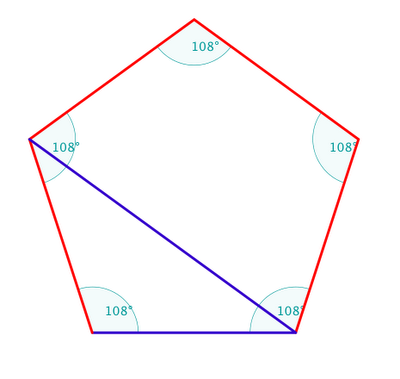You have a problem
 A regular pentagon "P" has a side length of 2. A new regular hexagon "Q" is made with the side equal to the diagonal of the pentagon "P". The ratio of the area of the hexagon "Q" by the perimeter of pentagon "P" can be expressed as
B
A
(
3
3
+
C
)
.
A regular pentagon "P" has a side length of 2. A new regular hexagon "Q" is made with the side equal to the diagonal of the pentagon "P". The ratio of the area of the hexagon "Q" by the perimeter of pentagon "P" can be expressed as
B
A
(
3
3
+
C
)
.
A third degree polynomial equation that gives us the A,B and C as roots can be written by: x 3 + a x 2 + b x + c .
Find a+b+c
The answer is -253.
This section requires Javascript.
You are seeing this because something didn't load right. We suggest you, (a) try
refreshing the page, (b) enabling javascript if it is disabled on your browser and,
finally, (c)
loading the
non-javascript version of this page
. We're sorry about the hassle.
2 solutions
Your last step was tedious. Just put x=1 and see what happens.
Log in to reply
We will get answer as - 252 and the solution not correct !!!
Log in to reply
No I never said that type the answer as it is. I just said put x=1 and see what happens. Of course 1 had to be subtracted.
It's not tedious. "See what happens" is not what mathematicians do, we work with precision, not try and error
Log in to reply
It really would have been good man if the answer had been elegant. You really know how to give scares.
Sin 54= 4 5 . In the isosceles triangle with equal sides 2 and angle between as 108 =54 * 2, the base, that is diagonal of P = 2 * side*Sin54= 5 + 1 . This is the side of Q. S o a r e a o f Q = 6 ∗ 4 3 ∗ ( 4 5 ) 2 = 3 ( 3 3 + 1 5 ) . P p e r = 2 ∗ 5 = 1 0 . ∴ t h e r a t i o = 1 0 3 ∗ { 3 3 + 1 5 } . U s i n g V i e t a ′ s w i t h A = 3 , B = 1 0 , C = 1 5 , a = − ( A + B + C ) , . . b = A ∗ B + B ∗ C + C ∗ A , . . c = − A ∗ B ∗ C , . . . a + b + c = − 2 5 3 .
Good solution, but you are supposed to solve that without using any calculator, and I believe most people don't know by heart the sin(54).
As seen on the image above, where d is the pentagon diagonal and l is the side, △ A B F ≃ △ C E F . Let l = 1; d − 1 1 = 1 d . Solving this equation will lead to d = 2 ( 1 + 5 ) . We have just defined the ratio Side/Diagonal.
The Length of the sides of the regular pentagon is 2, and the ratio Side/Diagonal can be expressed as 2 l ( 1 + 5 ) . We can admit now that the side of the hexagon is equal to 1 + 5 .
A regular hexagon can be split into 6 equilateral triangles. That said, the area of it is equal to 4 6 ( 1 + 5 ) 2 3 Solving the equation above you will end up with 3 ( 3 3 + 1 5 )
The ratio (Area of Hexagon)/(Perimeter of Pentagon) will be 1 0 3 ( 3 3 + 1 5 )
A = 3; B = 10; C = 15;
To find the Polynomial equation you simply need to multiply: (x-3)(x-10)(x-15)
That will give you the final result of x 3 − 2 8 x 2 + 2 2 5 x − 4 5 0
a = -28 b= 225 c = -450
a+b+c = -253.